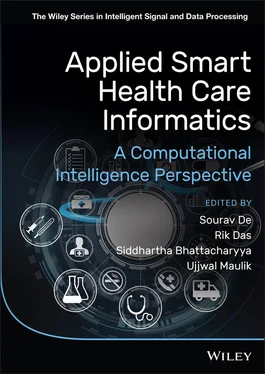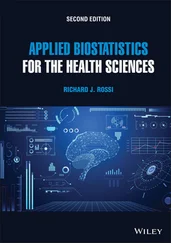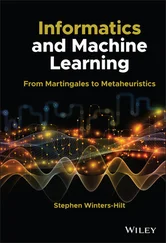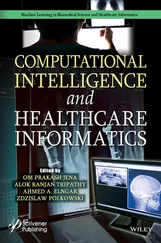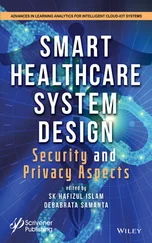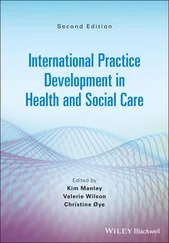Health care informatics, also referred as biomedical or medical informatics, is an application of information engineering and management in the medical field. Health care fundamentally covers the management and employment of patient health care information. It is a multidisciplinary field that studies and pursues the effectual use of biomedical data, knowledge for scientific inquiry, information, problem solving, and decision making. Chapter 1provides an overview of a few smart healthcare practices.
Lung cancer is a fatal form of cancer around the world. The American Lung Association reports an estimated five‐year survival rate in lung cancer patients of 18.6%. The statistics affirm that the survival rate is significantly lower than in other forms of cancer. However, the five‐year survival rate stands at 56% when the disease is diagnosed in a localized stage. Some cases do not appear to have symptoms until cancer has reached a later stage. The primary cause of concern is the low percent of early lung cancer detection, which is merely 16%. Lung cancer staging is a procedure associated with the disease's successful prognosis and formulation of an efficient treatment plan. Medical imaging techniques play a vital role in the diagnosis of lung cancer. Accuracy is crucial in treatment as lung cancer is influenced by internal and external factors or mistaken for other pulmonary diseases. The staging of cancer allows for the significant elimination of treatment failures. However, cancer staging is a dynamic process that involves multiple and frequent modifications to recognize organ features. The staging process requires a more robust and automated technique that can provide sensitive and unique input to improve the overall treatment process. Thus, artificial intelligence sub‐branches such as deep learning play a vital role in initiating such improvements for an efficient cancer staging process. Chapter 2uncovers the potential of a deep learning model combined with positron emission tomography—computed tomography (PET‐CT) to develop a technique that identifies tumors with more precision. The proposed research will assist doctors in accurately measuring the tumor and identifying the stage of lung cancer that will determine further treatment and an exact prognosis.
Cyber‐physical attacks (CP attacks), originating in cyber space but damaging physical infrastructure, are a significant recent research focus. Such attacks have affected many cyber‐physical systems (CPSs) such as smart grids, intelligent transportation systems, and medical devices. In Chapter 3, the authors consider techniques for the detection and mitigation of CP attacks on medical devices. It is obvious that such attacks have immense safety implications. This work is based on formal methods, a class of mathematically founded techniques for the specification and verification of safety‐critical systems. The interaction of a cardiac pacemaker is discussed. Subsequently, the authors provide an overview of formal methods with particular emphasis on run‐time based approaches, which are ideal for the design of security monitors. Two recently developed approaches are illustrated that assist in the detection of attacks as well as mitigation.
Integrating heterogeneous omics data profiles, such as genomics, epigenomics, and transcriptomics may provide new insights into discovering some unknown genomic mechanisms involved in cancer and other related complex diseases. The alterations of multiple omics, including gene mutations, epigenetic changes, and gene regulation modifications, are responsible for tumor initiation and cancer progression. Most of the multi‐view data profiles contain a huge number of genes, many of which are redundant, noisy, and irrelevant. It is computationally impractical to use these massive data sets without any filtering of the feature set. High performance (deep) machine learning strategies now appear to be an essential tool to learn the hidden structure from the data. In Chapter 4, the authors have proposed a two‐step approach to systematically identify gene signatures from multi‐omics head and neck cancer data. First, an autoencoder‐based strategy is used to integrate gene expression and methylation data. From this, the features are extracted by using the information from the bottleneck layer of the autoencoder. The features represent the combined representation of the two omics profiles. Next, the features that stem from the integrated data are applied to learn another deep learning model called the capsule network. The coupling coefficients between primary and output capsules are also analysed to interpret the features captured by the capsules.
The last two decades have witnessed unprecedented advancements in computational techniques and artificial intelligence. These new developments are going to greatly impact biological data analysis for the health care system. In fact, the availability of large scale high‐throughput biomedical data sets offers a fertile ground for application of these AI‐based techniques in to extract valuable information that can be harnessed in the diagnosis and treatment of various diseases. Chapter 5provides a comprehensive review of computational tools and online resources for high throughput analyses of biomedical data. It focuses on single‐cell RNA sequencing data, multi‐omics data integration, drug design with AI, medical imaging data analysis, and IoT. After providing a brief overview of the fundamental biological terms, a variety of research problems are described in the health care system and how various high throughput data can help solving them. Next, an in depth overview of machine learning techniques of computing and learning methods that can be used in a variety of sequencing data analyses is provided.
Cancer is one of the most devastating diseases worldwide. It affects nearly every household, although cancer types are prevalent in different geographical regions. One example is breast cancer, which is the most common type of cancer in women worldwide. Therefore, prevention strategies are needed to address this issue. Identifying risk factors of breast cancer is crucial since it allows physicians to acquaint them with the risks. Accordingly, physicians can recommend precautionary actions. In the first part of Chapter 6, the authors detail the discovery of significant rules for breast cancer patients, focusing on different ethnic groups. Predicting the risk of the occurrence of breast cancer is an essential issue for clinical oncologists. A reliable prediction will help oncologists and other clinicians in their decision‐making process and allow clinicians to choose the most reliable and evidence‐based treatment. In the second part of the chapter, a super learner or stacked ensemble technique is employed to the breast cancer data set obtained from the Breast Cancer Surveillance Consortium (BCSC) database. A comparison of the performance of the super learner and the individual base learners is conducted. The results of the first part of this study (rule extraction from breast cancer patients in distinct ethnic groups) found well‐known ethnic disparities in cancer prevalence. The experimental results revealed that the produced rules hold the highest confidence level. The crucial rules, which can be easily understood, are also interpreted.
Negative‐stain transmission electron microscopy (TEM) is considered a fundamental approach for virus detection and identification. In this context, Chapter 7presents a new architecture, based on neuro‐rough hybridization, for the analysis of TEM images. It assumes that a specific local descriptor at a given scale may be relevant in classifying a particular pair of virus classes but may not be able to encapsulate the inherent characteristics of another pair of classes. Important features from class‐pair relevant descriptors are, therefore, first identified using the rough hypercuboid approach, and then discriminatory features are learned using the contrastive divergence algorithm of the restricted Boltzmann machine (RBM). Finally, a support vector machine (SVM) with a linear kernel is adopted to categorize the TEM images into one of the known virus classes. The proficiency of the proposed approach with respect to several state‐of‐the‐art methods was established on a publicly available, benchmark Virus data set.
Читать дальше
